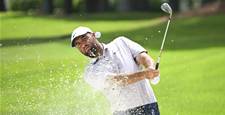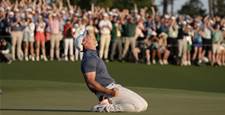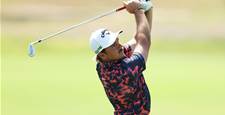These items are so fundamental to our workouts or recreational activity, we tend to forget somebody had to come up with them.
Here are five figures who truly changed how we played.
Sports shoes
Rubber companies had made shoes such as plimsolls since the late 19th century. But the first recognisable sneaker that endures to today came from Converse, the “Non-Skid” of 1917. These shoes would become famous by another name after basketball player Chuck Taylor joined the company in 1923 – his tireless work in promoting the sport also served to promote the shoes, and established the industry’s model of athlete endorsement.
 In other parts of the world, other shoe brands were emerging. The German brothers Adolf and Rudolf Dassler had equipped athletes in the 1936 Olympics, but suffered a notorious falling-out after World War II. In the split, Adolf kept their company and renamed it Adidas, while Rudolf went off to form Puma, creating a pair of influential style-makers. In Japan, the Onitsuka Tiger company had early success designing shoes for distance running, attracting the attention of a former American college runner, Phil Knight. He set up a company to import the shoes, and eventually set off to make shoes of his own – what would eventually become known as Nike.
In other parts of the world, other shoe brands were emerging. The German brothers Adolf and Rudolf Dassler had equipped athletes in the 1936 Olympics, but suffered a notorious falling-out after World War II. In the split, Adolf kept their company and renamed it Adidas, while Rudolf went off to form Puma, creating a pair of influential style-makers. In Japan, the Onitsuka Tiger company had early success designing shoes for distance running, attracting the attention of a former American college runner, Phil Knight. He set up a company to import the shoes, and eventually set off to make shoes of his own – what would eventually become known as Nike.
Anaconda is Australia’s largest outdoor & adventure retailer ranging from gym & sports equipment, camping & hiking gear, fishing, boating, cycling and more! Check online to view the full range.
Inflatable ball
 The notion of a light, inflatable and round object first took hold in medieval Europe, when the bladders of pigs would be kept, dried, blown up and feature in a game in which the participants would keep the object in the air using hands and feet.
The notion of a light, inflatable and round object first took hold in medieval Europe, when the bladders of pigs would be kept, dried, blown up and feature in a game in which the participants would keep the object in the air using hands and feet.
By the mid-19th century, the rules of various sports were being made more uniform, and the equipment along with it. But a standardised ball wasn’t possible until Charles Goodyear, of tyre fame, patented vulcanised rubber in 1836. The rubber ball, designed by Goodyear in 1855, eliminated the element of unpredictability caused by irregularly shaped balls.
However, it wasn’t until 1862 that the first inflatable bladder for insertion into the ball was developed by H.J. Lindon, who, legend has it, invented the India rubber version after his wife died of lung disease from blowing up infected pig bladders; the Lindons were involved in the manufacture of early rugby balls using the pig bladders.
Weights
 Eugen Sandow has been dubbed the “father” of modern bodybuilding. He amazed audiences in the late 19th century with his perfect physique. But Sandow was also a key figure in synthesising ideas about weight training that modern CrossFitters would recognise – he was probably more strength athlete than bodybuilder. He took part in a strongman contest in London at 21, and beat the reigning champion easily. He achieved victories over champion wrestlers as well, in the days when wrestling was solely an authentic sporting pursuit.
Eugen Sandow has been dubbed the “father” of modern bodybuilding. He amazed audiences in the late 19th century with his perfect physique. But Sandow was also a key figure in synthesising ideas about weight training that modern CrossFitters would recognise – he was probably more strength athlete than bodybuilder. He took part in a strongman contest in London at 21, and beat the reigning champion easily. He achieved victories over champion wrestlers as well, in the days when wrestling was solely an authentic sporting pursuit.
Sandow was a scholar of physical development, and as with many of them, he delved into ancient Greece, and the “gymnasium”, studying its methods. He’d visit museums for his own, very specific, reasons. He invented his own apparatus for physical development, going beyond the dead weights that were the current trend. These novel devices included weights with spring grips that targeted wrist strength, and rubber bands for stretching exercises.
Composite tennis racquet
 The composite tennis racquet’s arrival ushered in a new era of power and fitness. Its driver was legendry Czech player Ivan Lendl.
The composite tennis racquet’s arrival ushered in a new era of power and fitness. Its driver was legendry Czech player Ivan Lendl.
By the end of the 1970s, the aggressive baseliner was common in elite tennis, but before 1975, three of the Opens (Australian, Wimbledon and the US) were still being played on fast grass, and the chip-and-chargers, the serve-and-volleyers, still got a look in. John McEnroe came to dominate, and the tradition of exciting exponents like Budge, Laver, Gonzales, Newcombe and Rosewall, King, Navratilova and Goolagong-Cawley, was still alive.
Then the wooden racquet went the way of the dodo, giving way to a composite model.
This ushered in a new era of power and fitness, embodied in one man: the frighteningly efficient Lendl. His ability to pull off pacey topspin-enhanced passing shots, his introduction of brand-new, radical angles from the baseline thanks to vicious dip, made him the real pioneer.
Treadmill
 A concept initially devised for convicts to crush corn and pump water eventually became the most popular training aid for the masses. It is believed the concept of a human leg-powered device to serve as a sort of winch, or crane, was first devised by the Romans when the empire was at its height and construction was central to its prosperity.
A concept initially devised for convicts to crush corn and pump water eventually became the most popular training aid for the masses. It is believed the concept of a human leg-powered device to serve as a sort of winch, or crane, was first devised by the Romans when the empire was at its height and construction was central to its prosperity.
It took a while for anyone to wake up to the possibility that this ingenious device could be used for any purpose other than punishment or production. In 1952, however, two doctors from Washington University, Robert Bruce and Wayne Quinton, used an updated version to test the heart-lung capacities of patients.
Bruce became known as the father of “exercise cardiology”, and his “Bruce protocol”, which tested cardiac patients with exercise (the accepted wisdom was that people with heart conditions rest) became popular in the medical profession and is still used today.
Related Articles
.jpg&h=172&w=306&c=1&s=1)
Tested: WHOOP 4.0

Barty headlines NZ Open ambassador line-up













